History & Architecture of Centre Block
- Centre Block Exterior
- Centre Block Underground Services (CBUS)
- Hall of Honour
- House of Commons Foyer
- Senate
- Rotunda
- Peace Tower
Centre Block Exterior
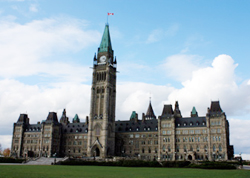
The Centre Block is made of sandstone from Nepean, Ontario, Ohio, United States, and Wallace, Nova Scotia. Its south facade alone contains 550 windows and approximately 50,000 stones.
The Centre Block is only one of the magnificent Gothic Revival buildings gracing Parliament Hill, but it is probably the one most quickly recognized by Canadians coast to coast.
Centre Block Underground Services (CBUS)
Besides being the home to the Senate, the House of Commons and the Library of Parliament, the Centre Block also contains many important offices and facilities. These include the Prime Minister's Office, the Office of the Leader of the Opposition and those of other party leaders, the offices of many Senators, Ministers and Members of Parliament, House of Commons staff, several Parliamentary Committee rooms, the Parliamentary Press Gallery, and many others.
In this era of computers, fax machines and the Internet, all of these busy offices require a great deal of electricity, as well as space for advanced systems. To deal with these pressing needs, Public Works and Government Services Canada built the Centre Block Underground Services facility, known as "CBUS" for short.
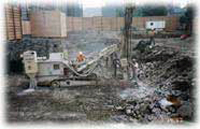
Buried 12 m (39 ft. 4 in.) underground, at the northwest corner of the Centre Block, there is now a two-storey, 4,000 m2 (13,123 ft2) facility. CBUS houses new high-voltage electrical transformers and emergency power generators, provides space for advanced computer and communications facilities, and provides much-needed storage space and delivery reception facilities.

The first challenge of the CBUS project was to dig the rock out. A combination of hoe-ramming and monitored and controlled blasting did the trick. In all, eight tons of explosives were used during the excavation process, which was carried out 24 hours a day, from May to September 1997.
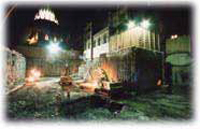
Approximately 30,000 m3 (98,425 ft3) of rock was removed from the site. It took 3,000 double-axle dump trucks, working 24 hours a day from May to September 1997, to remove the rock.
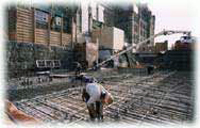
Once the rock was removed, the way was paved to build the concrete structure, which took 570 truckloads of concrete.
The entire construction process was closely monitored by the National Research Council and the Federal Heritage Building Review Office to protect the heritage characteristics of all buildings.
Hall of Honour
Separating the Centre Block into east and west sections, the Hall of Honour serves as the principal ceremonial space and a dividing line between the House of Commons and the Senate.
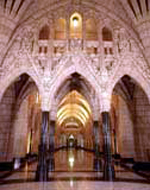
Its beautiful vaulted ceilings and extensive bosses are a magnificent example of High Gothic Revival. Superb craftsmanship can be found throughout the Hall. The ironwork done by the incomparable Paul Beau is most noteworthy. His energetic designs work perfectly beside the decorative Gothic stonework.
The Hall of Honour was intended to commemorate events and individuals with distinctive plaques and sculptures. With only a small group of sculptures at the North end, it has come to be a place of symbolic honour. It pays tribute to the people and traditions of Parliament as well as all those who pass through its noble limestone arches. Cutting through the heart of the building, it links all the elements of Centre Block together.
At the end nearest to the Library of Parliament, the Hall of Honour comes closest to its original purpose. A diverse group of sculptures and plaques pays tribute to events and people of Canada's past.
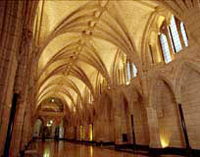
The largest is a memorial to nursing in Canada. Its themes of nurses as early nation-builders and as participants in the First World War are continued in other sculptures. The Canada Remembers carving pays tribute to all Canadians involved in the Second World War and two other works commemorate the efforts of nation building.
As well as part of the route of the House of Commons Speaker's Parade, the Hall of Honour has been the location for several exceptional events. Several Canadians, including former Prime Minister Pierre Elliott Trudeau and Canada's Unknown Soldier, have lain in state here. The solemnity of its gothic character suits it perfectly to these purposes.
The particular gothic character of the Hall of Honour was achieved in the reconstruction of Centre Block after the 1916 fire when there was a shift from warm and many coloured textures to more muted tones and textures.
The Hall of Honour is also the main thoroughfare of Centre Block: a corridor where librarians cross paths with bustling groups of visitors; where journalists gather to catch up with Parliamentarians, where witnesses spill out of parliamentary committees and where everyone has the chance to symbolically see themselves reflected in the building.
House of Commons Foyer
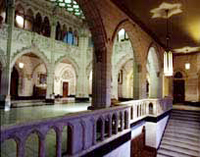
The Foyer is probably most familiar to Canadians as the setting for the ritual known as "the scrum", where Members of Parliament field questions, surrounded by journalists, cameras and tape recorders, following Question Period and debates in the House of Commons.
The House of Commons Foyer is the meeting place of many of the elements of Parliament and Centre Block. Parliamentarians' offices ring its edges, the media and Members meet on its floor to bring the stories of the day's debates and decisions into homes all across Canada and its shape combines a sombre atmosphere with fantastical sculpted detail.
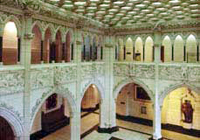
Of the rooms in Centre Block, this one best combines the solemnity of the purpose of Parliament with the vibrancy of its people and its past. Vaulted ceilings, marble floors and dramatic lighting provide the setting for the lively exchanges between journalists and Parliamentarians and for the passage of one of the House of Commons' most ancient traditions, the Speaker's Parade.
Like the on-going evolution of Parliament and Canada, the creation of this room has been the work of many designers, artists, sculptors and workers over many years. Rebuilt from 1916 to 1920 after the fire, its decoration is still not complete.
Two broad bands of sculpture circle the foyer. Eleanor Milne completed the lower wide band of ten panels in 1975 after 13 years of work. She combined art, history and philosophy to bring to life thousands of years of history. In the upper band, flowers of the provinces curl around their coats of arms. Separating the provinces are representations of Canada's industries and the people who drive them.
The earliest sculptures in this room, exaggerated human faces and mythical beasts, carved in 1919 mix easily with the work of the Native Sculptors Series. The carved and painted faces of Canada's past Prime Ministers and other members of the House of Commons assist today's media in keeping a watchful eye on their successors.
Senate
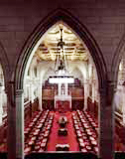
At the east end of the Centre Block, the Senate Foyer and Chamber present an air of regal splendour.
The Upper House of Canada's Parliament, the Senate plays a central role in our country's legislative process, examining and debating bills passed by the House of Commons as well as introducing new legislation.
Senate Foyer

The design of the Senate Foyer succeeds in blending artistic elegance with functionality.
Visitors to the Senate Foyer are often impressed by its dignified elegance. The Foyer is framed by a series of columns and arches rising to the ceiling. A second arcade with columns of rose-coloured limestone (its reddish tinge chosen for its historical association with the Upper House) adds to the refined appearance of the space.
Under flashes of red and the royal gaze of past sovereigns, the Senate Foyer reveals that Canada is a constitutional monarchy. It is the dignified ceremonial entrance to the Senate Chamber where the sovereign or her representative the Governor General addresses Parliament. Its artisanship reveals the struggles and successes of Canada and Parliament's evolution with reverence and even humour.

Eight paintings of past kings and queens line the Foyer walls. The portraits of King George IV and Queen Victoria are original; the latter having been saved from flames four times.
The foyer is also the backdrop for several of the traditions that link the Senate to its origins. The chamber officials dressed in sombre black robes as part of the Speaker's Parade, and the Usher of the Black Rod who summons the Members of the House of Commons, all pass through here.
In the vivid colours of the stained glass ceiling, royal symbols share space with provincial coats of arms and symbols of the founding peoples of Canada. The ceiling also includes the names of all the Senate Speakers up to its installation in 1920.
Under the ceiling sculptures pay tribute to the people and the events that shaped Canada before Confederation. These sculptures were completed by a team of four sculptors who decided to add to the legends they had carved. Without permission, they added their own faces to the foyer continuing the gothic tradition of including secret faces and signatures in buildings that took decades of work and hundreds of workers to complete.
Senate Chamber
The Upper House of Canada's Parliament, the Senate plays a central role in our country's legislative process, examining and debating bills passed by the House of Commons.
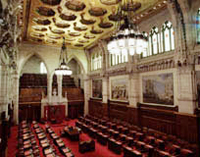
Entering the Senate Chamber for the first time can take one's breath away. Masterful stone and wood carvings, beautiful paintings, large ornate chandeliers, the gilt coffered ceiling, and brilliant red carpeting and accents all lend a sense of grandeur to this proud historic chamber.
Brilliant in royal red and gold, the Senate Chamber is where the Queen or her representative, the Governor General, addresses Parliament and gives assent to bills destined to become law. The Senate is also an equal partner in the legislative process: it is where Senators debate and revise bills passed by the House of Commons, investigate national issues, represent and protect regional, provincial and minority interests and introduce new legislation.
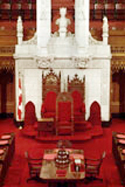
Senators are appointed by the Governor General on the recommendation of the Prime Minister. Senators represent regions and provinces in order to balance the representation in the House of Commons. Less populated regions have a stronger voice in the Senate so as to ensure representation for regional and minority interests.
The 105 Senators come from a variety of backgrounds. Able to serve in the Senate until 75, they develop a thorough understanding of complex issues facing Canada, often through their work in Senate committees and their experience outside of the Senate.
As the "chamber of sober, second thought", the Senate plays an essential role in the legislative process, particularly in the review and revision of legislation passed by the House of Commons. The Senate's agreement is needed before any bill can become law.
The Speaker presides over the business of the Senate, assisted by the Clerk and other table officers. To the Speaker's right sits the government party, led by the Leader of the Government and to the left, the opposition, led by the Leader of the Opposition.
The thrones behind the Speaker are for the Queen or the Governor General and his or her consort. The red carpet, the gold coffered ceiling, the massive bronze chandeliers and the intricate carved stonework highlight the Chamber as a place for ceremony and confirms its significance in Canada's Parliamentary system.
Rotunda
The Rotunda, also called Confederation Hall, is located inside the main entrance of the Centre Block.
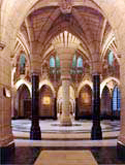
The Rotunda is the heart of the Centre Block. To the north, at the other end of the Hall of Honour, is the Library of Parliament. The Rotunda marks also the midpoint of the main south corridor running between the House of Commons at the west end of the building and the Senate at the east end.
The Rotunda, also called the Confederation Hall, is the formal entrance to Centre Block. Its grandeur immediately reveals the significance of the building and the institutions it houses. It welcomes visitors with an elaborate representation of Canada's political landscape. With carved and sculpted symbols of every province and territory, it also welcomes every Canadian home.
Imposing and dignified, the Rotunda reinforces Centre Block as a Neo-Gothic building. Soaring across the high vaulted ceiling, arcs join together at the central column. This column dominates the room, as if channelling all the energy of the building and anchoring it firmly there.
An intricate inlaid marble pattern swirls around the base of the column, representing the water that has been so vital in Canada's development and alludes to Canada's motto: From Sea to Sea. A mariner's compass seems to symbolise that Canada's vastness stretches out in all directions.
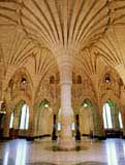
From its initial designs in 1916, the Rotunda was meant to represent the coming together of the diverse elements of Canada in a strong federation. Each one of the provinces and territories, including those that joined after the construction of the room are represented by their coats of arms. Thirty different animals found across Canada cavort around these symbols.
The Rotunda tells another, less obvious story. While it reflects the importance of Confederation, it also tells what was important to Canada at the time it was built. The inscription on the central column bears a dedication to those that participated in the First World War.
Centre Block was rebuilt as the war raged. Many of the engineers, craftsmen and labourers were involved in the war. So the reconstruction, just as Canada's participation in the war, is also the story of ordinary Canadians doing extraordinary things in extraordinary times.
Peace Tower
The Peace Tower, so named to honour the thousands of Canadian men and women who sacrificed their lives for their country in World War I, stands at the front of the Centre Block.
Like the present Centre Block, the Peace Tower differs markedly from the structure it replaced. While the old Victoria Tower was an integral part of the first Centre Block, the Peace Tower is a campanile, or freestanding bell tower.
Its walls are made of Nepean sandstone. They rise 97.9 m (321.2 ft.) high. The roof is reinforced concrete covered with copper. The Tower contains an observation deck, a clock with four faces 4.8 m (16 ft.) in diameter, a carillon and the Memorial Chamber, honouring Canada's war dead.
- Date modified: